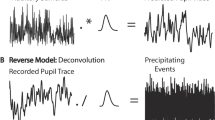Abstract
Although eye movement saccades are stereotyped, repeatable movements, the shape of the neural controller signal innervating the extraocular muscles is a matter of controversy. Different lines of evidence — single motoneuron recordings, electromyograms, and dynamics — lead to different conclusions. Although all agree that the controller is, in outline, a pulse-step of net activity, neither the pulse width nor shape of the trailing edge of the pulse is clear. We use a mathematical model of the eye and two extraocular muscles to link the dynamical data to the electrophysiological evidence. We conjecture a multipulse controller signal, based on the application of an optimality principle to our model. This multi-pulse controller signal raises new possibilities for resolution of the pulse shape ambiguities, and resolves the controversy over pulse width.
Similar content being viewed by others
References
Clark, M.R.: The time optimal and nonlinear system dynamics of human eye tracking movements. Ph. D. dissertation, University of California, Berkeley 1973
Collins, C.C.: The human oculomotor control system. In: Basic Mechanisms of Ocular Motility and Their Clinical Implications, Lennerstrand, G., Bach-y-Rita, P. (eds.) Oxford, New York: Pergamon Press 1975
Collins, C.C., Scott, A.B.: The eye movement control signal. Proc. Second Bioengineering Conference, Ophthalmology Section, Milan, Italy, November 1973
Cook, G.: Control systems study of the saccadic eye movement mechanism. Ph. D. dissertation, Cambridge, MA: M.I.T. Press 1965
Fuchs, A.F., Luschei, E.S.: Firing patterns of abducens neurons of alert monkeys in relationship to horizontal eye movement, J. Neurophysiol. 33, 382 (1970)
Goldberg, J.: Ph. D. dissertation, University of California, Berkeley, 1979
Keller, E.L.: Oculomotor neuron behavior. In: Models of Oculomotor Behavior and Control, Zuber, B.L. (ed.) Boca Raton, FL: CRC Press 1981
Kenyon, R.V., Stark, L.W., Scott, A.B.: Human electromyography of saccades with dynamic overshoots (submitted)
Lehman, S.L., Stark, L.W.: Simulation of linear and nonlinear eye movement models: sensitivity analyses and enumeration studies of time optimal control. Cybern. Inform. Sci. 4, 21 (1979)
Reinhart, R.J., Zuber, B.L.: Abuncens nerve signals controlling saccadic eye movements in the cat. Brain Res. 34, 331 (1971)
Robinson, D.A.: Oculomotor unit behavior in the monkey. J. Neurophysiol. 33, 393 (1970)
Robinson, D.A.: The mechanics of human saccadic eye movement. J. Physiol. 174, 245–264 (1964)
Schiller, P.H.: The discharge characteristics of single units in the oculomotor and abducens nuclei of the unanesthetized monkey. Exp. Brain Res. 10, 347 (1970)
Sindermann, F., Geiselmann, B., Fischler, M.: Single motor unit activity in extraocular muscles in man during fixation and saccades. Electroencephalog. Clin. Neurophysiol. 45, 64 (1978)
Westheimer, G.: Mechanism of saccadic eye movements. AMA Arch. Ophthalmol. 52, 710–724 (1954)
Author information
Authors and Affiliations
Rights and permissions
About this article
Cite this article
Lehman, S.L., Stark, L.W. Multipulse controller signals. Biol. Cybern. 48, 1–4 (1983). https://doi.org/10.1007/BF00336877
Received:
Issue Date:
DOI: https://doi.org/10.1007/BF00336877




